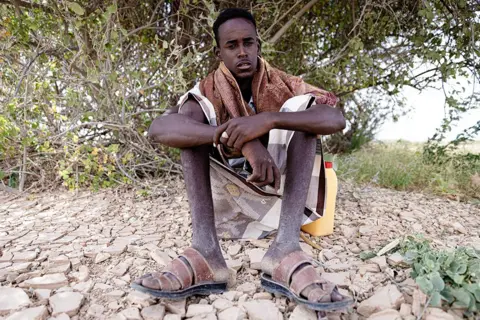
Climate change is turbo-charging Somalia’s problems
- Science
- September 21, 2024
- No Comment
- 129
 Alyona Synenko/ICRC
Alyona Synenko/ICRCSomalia may be one of the poorest countries in the world and beset by violence, but it is “fixable”, according to its top climate official.
The country has been torn apart by more than 30 years of overlapping conflicts – including an Islamist insurgency, a civil war, and a series of regional and clan confrontations. Yet Abdihakim Ainte, the Somali prime minister’s climate advisor, still regards his country as “as story of potential – of promise”.
What makes his optimism all the more surprising is the fact climate change is amplifying virtually all the challenges his country faces.
One commentator described climate change as a “chaos multiplier”, because it exacerbates existing tensions and entrenches conflict in fragile states like this.
 Alyona Synenko/ICRC
Alyona Synenko/ICRCIn 2022 the country experienced its worst drought for 40 years – an event scientists estimate was made 100 times more likely by human-caused climate change.
The extent of the challenge Somalia faces became clear as the convoy of International Red Cross (ICRC) Land Cruisers we were travelling in rumbled into the dry scrub that covers most of the country. We were accompanied by three guards clutching AK47s – Somalia is the only country in the world where Red Cross staff travel with armed security as standard.
 Alyona Synenko/ICRC
Alyona Synenko/ICRCThe camel herders and small-scale farmers we met are on the front line of climate change here. For thousands of years Somalis have been eking out a living moving their herds of camels and goats from one pasture to the next across this dry land.
But climate change is disrupting the patterns of rain that made this way of life possible.
Sheik Don Ismail told us he lost all his camels during the drought, when grazing grounds dried up and the fodder he grew on his small farm wasn’t enough to sustain them.
“The well became dry and there was no pasture, so the animals began to die,” he said, shaking his head. “The life we lead now is really bad – really bad.”
That drought left farmers and herders fighting for access to water and pasture. Sheik Don said he was sometimes forced to defend his land at gunpoint.
“There is no respect if you don’t have a gun,” he said. “The herders who lead their animals into the farm stay back when they see my weapon. They get scared.”
In a country divided into rival clan groups and already scarred by violence, these localised disputes can easily spiral into full-blown battles, said Cyril Jaurena, who runs the ICRC operation in Somalia.
“Access to boreholes and pastureland gets more and more difficult to find, and so the population in the area might end up fighting – competing for those resources, and sometimes it goes to people shooting at each other,” he warned.
And drought isn’t the only problem here. Last year Somalia experienced terrible floods as a result of rains scientists say were made twice as intense by human-caused global warming. The floodwater washed away precious soils killing hundreds of people and displacing one million others.
 Alyona Synenko/ICRC
Alyona Synenko/ICRCThe effects of Somalia’s climate change “double whammy” are all too evident in the hunger clinic the Red Cross runs in a hospital in the port city of Kismayo on the south coast.
Every day a steady stream of mothers bring their malnourished babies here. Many have had to cross from territory controlled by al-Qaeda’s lethal affiliate, Islamist militants al-Shabab, to get here.
The UN estimates more than 1.5m children under the age of five are acutely malnourished in Somalia.
 Alyona Synenko/ICRC
Alyona Synenko/ICRCAround four million Somalis have been driven into vast makeshift refugee camps – about a fifth of the total population.
Displaced people make their homes out of anything they can get hold of – pieces of old fabric, plastic sheets and rusty corrugated iron – all draped over a web of dry sticks. Some people even unroll tin cans into strips to form parts of their walls.
There is little international support, if any. At the refugee camp I visited, just outside the city of Garowe in the north of Somalia, families have to pay for their food and water, as well as pay rent for the scraps of land where they build their shacks.
After more than three decades of war, Somalia has fallen way down the list of international priorities. Its problems have been eclipsed by what seem like more urgent conflicts, in places like Ukraine and Gaza. The UN calculates Somalia needs at least $1.6bn (about £1.2bn) to meet the basic humanitarian needs of the people this year, but so far just $600 million has been pledged by donor governments.
 Alyona Synenko/ICRC
Alyona Synenko/ICRCThe entwined impacts of climate and conflict have created a huge reservoir of potential recruits for the country’s many conflicts.
Those in the camps are desperate for money, and the easiest work to come by – according to the people I spoke to – is as a paid fighter with one of the many rival armies.
One woman told me of her fears for her husband and four of her five sons after they became fighters with a local militia.
“They are rural people with no skills, so the only work they could get was in the army,” Halima Ibrahim Ali Mohamud said as we sat on carpets laid over the dirt floor of her hut.
“They were desperate, and when you are without food long enough, and your children are looking at you, you will do anything.”
As we went from shack to shack, mothers told us similar stories of husbands and sons who had left to become fighters, some of whom had been killed.
 Alyona Synenko/ICRC
Alyona Synenko/ICRCBut many Somali people are taking action. The local power station in Garowe has been investing in wind and solar power, for example.
The decision wasn’t prompted by some international initiative, says the company CEO. Abdirazak Mohamed said he hasn’t received any grants or aid from abroad. Newsportual Energy Corporation of Somalia (NECSOM), who he works for, is making the investments because renewables – energy derived from natural sources like the sun and the wind – are much better value than the diesel generators the power station used to rely on.
 Alyona Synenko/ICRC
Alyona Synenko/ICRCI met Somali entrepreneurs setting up businesses, including a woman who had arrived in the Garowe refugee camp with nothing, but who set up a thriving business.
Amina Osman Mohamed explained how she had borrowed food from a local stall, cooked it, and used the small profit she made to do the whole thing again the following day.
The small but busy café she created generates the extra cash she so desperately needs to care for her sick husband and 11 children – including those of her widowed daughter.
As I left Amina’s bustling café, I began to understand why the Somali prime minister’s climate advisor is optimistic about his country’s future.
There is hope. But with climate change turbo-charging the conflict here, this country will need continued international help to make peace and build resilience against our changing climate.

#Climate #change #turbocharging #Somalias #problems










